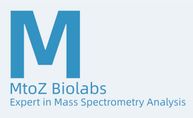
- Home
- Companies
- MtoZ Biolabs
- Services
- MtoZ Biolabs - Olink Analysis Service

MtoZ Biolabs - Model olink-proteomics - Olink Analysis Service
With the increasing focus on personalized healthcare, there is a growing demand for biomarkers for early diagnosis, prognosis, patient stratification, or monitoring treatment response. Compared with genetic biomarkers, protein biomarkers provide higher degrees of differential information. Olink proteomics is based on a unique proximity extension assay (PEA) technique that enables simultaneous quantification of multiple protein biomarkers. Olink PEA uses 2 matching antibodies for each target antigen. Each antibody pair is labeled with a unique DNA oligonucleotide barcode. When antibodies bind to the same target protein in solution, the DNA oligochain will anneal to sufficient stability to achieve DNA elongation. Then the DNA barcode is amplified and the amplicons obtained through qPCR or next-generation sequencing (NGS) is measured for absolute or relative quantification. PEA can detect protein with high sensitivity.
Olink proteomics provides high-throughput solutions for protein biomarker discovery, enabling the detection of numerous proteins in biological samples with concentration low to microscale, and its analytical methods are rigorously validated, which can provide superior specificity at multiple levels. Due to its high sensitivity and high throughput, Olink proteomics has been widely used in the fields of biomarker discovery, disease mechanism research, drug development and personalized healthcare. In clinical biomarker research, it can be used in all stages of drug development, including early detection and preclinical and clinical development.
1. Minimum Clinical Sample Concentration (Plasma/Serum as Low as 1 µL)
2. High Sensitivity to Protein Detection, Similar to ELISA or Better
3. Improved Accuracy of Multiple Detection and Intermediate Multiple Detection (with the Average Internal Coefficient of Variation (%CV) Lower than 10% and the Average Intermediate Coefficient of Variation (%CV) Lower than 20%)
4. More than 10 Logarithms of the Dynamic Range Which Is Ideal for Study of Plasma Protein Group
5. High Specificity of Protein Detection Aouble Recognition of Two Antibodies and Unique DNA Barcode of each Protein without Cross-reactivityvailablethrough D
1. Drug Target Identification
(1) Identify protein quantitative trait loci (pQTLs) to link genetic variations, proteins, and diseases.
(2) Delve into tumor biology, immune regulation mechanism, phenotypic change, and the transition from cold tumor to hot tumor.
2. Biomarker Analysis and Screening
Analyze longitudinal biomarker data between early and late time points to identify key biomarkers related to the transition from drug sensitivity to drug resistance.
3. Protein Response Validation in Clinical Trials
(1) Predict and monitor therapeutic response, sensitivity, and immune resistance mechanism.
(2) Guide strategies to optimize response rates and identify new target pathways.
4. Exploratory Endpoints in Clinical Trials
(1) Explore the correlation between circulating protein biomarker and clinical outcome.
(2) Predict the onset and mechanisms of treatment-related toxicity and monitor cytokine release syndrome and neurotoxicity.
(3) Predict relapse and treatment progression in adjunct therapy.
In the results report, MtoZ Biolabs will provide you with a detailed results report, which includes:
1. Experimental Procedures
2. Absolute Quantification Data (pg/mL) (Limited to Olink Target 48)
3. Relative Quantification Data: Expressed in Normalized Protein Expression (NPX) Format
4. Data Visualization: Includes Principal Component Analysis and Heatmaps to Visualize Sample Distribution and Protein Expression
5. Statistical Analysis: Includes Differential Protein Expression Analysis
1. Proteomics analysis
2. Quantitative Proteomics Analysis
3. Label-free Quantitative Proteomics Analysis
4. Label-based Protein Quantification Techniques - iTRAQ, TMT, SILAC
5. Protein Identification
MtoZ Biolabs is an integrate contract research organization (CRO) providing advanced proteomics, metabolomics, bioinformatics, and biopharmaceutical analysis services to researchers in biochemistry, biotechnology, and biopharmaceutical fields. The name of MtoZ represents “mass to charge ratio” in mass spectrometry analysis, as most of our services are provided based on our well-established mass spectrometry platforms. Our services allow for the rapid and efficient development of research projects, including protein analysis, proteomics, and metabolomics programs.
MtoZ Biolabs is specialized in quantitative multiplexed proteomics and metabolomics applications through the establishment of state-of-the-art mass spectrometry platforms, coupled with high-performance liquid chromatography technology. We are committed to developing efficient, and effective tools for addressing core bioinformatics problems. With a continuing focus on quality, MtoZ Biolabs is well equipped to help you with your needs in proteomics, metabolomics, bioinformatics, and biopharmaceutical research. Our ultimate aim is to provide more rapid, high-throughput, and cost-effective analysis, with exceptional data quality and minimal sample.
Email: marketing@mtoz-biolabs.com
MtoZ Biolabs adopts Olink Explore384/1536/3072, Olink Target 96, Olink Target 48 and Olink Flex protein detection platform developed by Olink company. Its unique PEA technology enables high-throughput, multiplex immunoassay-PCR. Simultaneous analysis of proteins with high specificity and sensitivity only need a minimum sample concentration (as low as 1 µL). The innovative dual-recognition and DNA-coupled approach have excellent read-out specificity and enables high-throughput, rapid-throughput identification of protein biomarkers. Click to view MtoZ Biolabs detectable protein markers.


